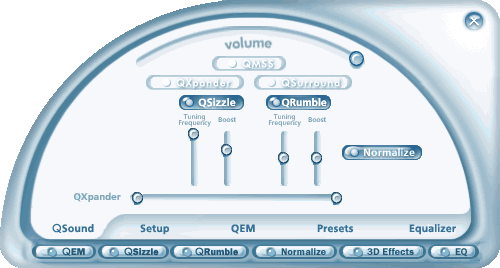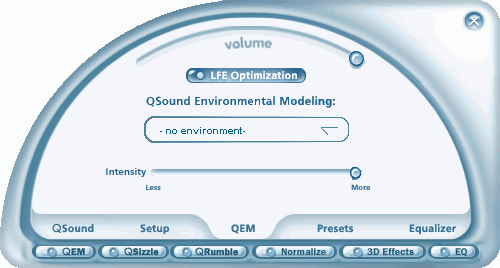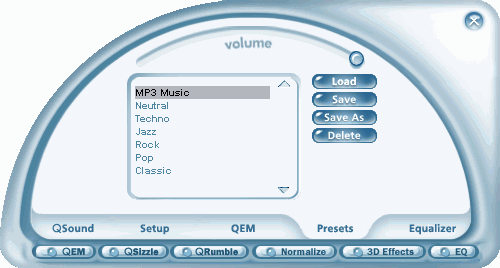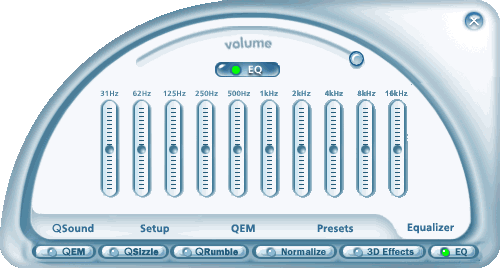Audiotrak Maya EX5 CE External 5.1 USB Surround Audio Solution
|
Audiotrak has launched an external USB device, Maya EX5 CE. It differs from the previous Maya EX5 product only in colors. The title of the new product now includes CE, which stands for Crystal Edition. Unfortunately, such a nice name did not affect technical characteristics of the device, all parameters remain the same. Thus, Crystal Edition means only a light design of the card.

The transparent enclosure contains a white PCB. All connectors are also made of white plastic.
Audiotrak Maya EX5 CE Specifications:
- full speed USB audio interface (USB 1.1 compatible)
- 2 channel analog line inputs, 3.5 mm jack, -10dBV unbalanced level
- 6 channel analog line outputs, 3.5 mm jack, -10dBV unbalanced level
- microphone preamplifier, +40dB fixed gain, 10K ohm
- headphone output, 3.5 mm mini phone jack, 60mW max. output
- headset connector, 3.5 mm jack
- natively supported samplerate: 48kHz
- resolution: 16-bit - digital I/O with coaxial input, coaxial output, mini optical output connector
- digital I/O format: 16-bit, 48kHz, S/PDIF (IEC-958)
- A/D converter: 91dB(a) dynamic range, frequency response: 20 Hz ~ 20 kHz, 18-bit resolution
- D/A converter: 88dB(a) dynamic range, frequency response: 20 Hz ~ 20 kHz, 18-bit resolution
- QSound driver engine supporting EAX1.0/2.0, A3D, Direct Sound 3D, QMSS, QExpander, QRumble, QSizzle, QEQ
- MME/WDM/ASIO compatible driver engine
- for Windows 2000/XP/2003
Audiotrak Maya EX5 is powered from USB. The device is plugged to a computer with a 1.5-m USB cable incorporated into the enclosure. There is no power switch on the card. However, when the interface is plugged, a blue LED lights up. There are no controls on the device, it's managed with software only.
The bundle includes a user manual, CD with drivers, and an adapter to use the headphone-out as an optical output.
The card uses the VIA VT1616 AC'97 codec as a converter.
RMAA Measurements
Device: ASIO 2.0 - MAYA EX5 CE
Features:
Input channels: 2
Output channels: 6
Input latency: 541
Output latency: 541
Min buffer size: 128
Max buffer size: 2048
Preferred buffer size: 256
Granularity: -1
ASIOOutputReady - supported
Sample rate:
8000 Hz - not supported
11025 Hz - not supported
16000 Hz - not supported
22050 Hz - not supported
32000 Hz - not supported
44100 Hz - supported
48000 Hz - supported
88200 Hz - not supported
96000 Hz - not supported
176400 Hz - not supported
192000 Hz - not supported
Input channels:
channel: 0 (USB 1 Audio Device) - Int32LSB
channel: 1 (USB 2 Audio Device) - Int32LSB
Output channels:
channel: 0 (USB 1 Audio Device) - Int32LSB
channel: 1 (USB 2 Audio Device) - Int32LSB
channel: 2 (USB 3 Audio Device) - Int32LSB
channel: 3 (USB 4 Audio Device) - Int32LSB
channel: 4 (USB 5 Audio Device) - Int32LSB
channel: 5 (USB 6 Audio Device) - Int32LSB
Analog Output
16 bit 44.1 kHz
Audiotrak Maya EX5 CE -> Audiotrak Maya EX5 CE
| Frequency response (from 40 Hz to 15 kHz),
dB |
+0.03, -0.26
|
Very good
|
| Noise level, dB (A) |
-79.6
|
Average
|
| Dynamic range, dB (A) |
79.6
|
Average
|
| THD, % |
0.013
|
Good
|
| Harmonic distortion + noise, dB(A) |
-71.1
|
Average
|
| Intermodulation distortion + noise, % |
0.031
|
Good
|
| Channel crosstalk, dB |
-67.4
|
Good
|
| IMD at 10 kHz, % |
0.033
|
Good
|
| General performance |
|
Good
|
General performance: Good (details)
Control panel
The control panel is implemented as a single window of an odd shape with five tabbed pages.
It should be noted that the manufacturer added sterling software support for QSound to this device.
Diagnostics in RightMark3DSound v2.3
Device: QVE for MAYA EX5 (qveEX5.sys)
Features:
DirectSound 2D Hardware: Yes
DirectSound 3D Hardware: Yes
EAX 1.0: Available
EAX 2.0: Available
EAX 3.0: N/A
EAX 4.0: N/A
EAX 5.0: N/A
Rates:
dwMinSecondarySampleRate 5000
dwMaxSecondarySampleRate 48000
Free buffers stats:
dwFreeHw3DAllBuffers 63
dwFreeHw3DStaticBuffers 63
dwFreeHw3DStreamingBuffers 63
dwFreeHwMixingAllBuffers 63
dwFreeHwMixingStaticBuffers 63
dwFreeHwMixingStreamingBuffers 63
Max buffers stats:
dwMaxHwMixingAllBuffers 64
dwMaxHwMixingStaticBuffers 64
dwMaxHwMixingStreamingBuffers 64
dwMaxHw3DAllBuffers 64
dwMaxHw3DStaticBuffers 64
dwMaxHw3DStreamingBuffers 64
Misc stats:
dwFreeHwMemBytes 0
dwTotalHwMemBytes 0
dwMaxContigFreeHwMemBytes 0
dwUnlockTransferRateHwBuffers 0
dwPlayCpuOverheadSwBuffers 0
When you work with the ASIO interface, the drivers automatically detect and set a necessary sampling rate. ASIO buffer size can also be changed without problems, but you can do it only in ASIO Control Panel.
On the whole, audio quality of the Audiotrak Maya EX5 CE is similar to that of the Creative Audigy2 cards. Our audition with Beyerdynamic DT250 headphones and Microlab SOLO-6 speakers did not reveal a noticeable advantage of the Audigy2. Thus, Audiotrak Maya EX5 CE is an alternative to the integrated AC'97 audio. Besides, the Maya EX5 CE is very convenient to use. All connectors are placed conveniently in full view. The headphones connector is placed separately, so you won't have to replug your cables, when you want to use your headphones. The card offers support for the professional ASIO interface and sterling software support for QSound simultaneously.
Write a comment below. No registration needed!
|
|
 |
|
|
|







